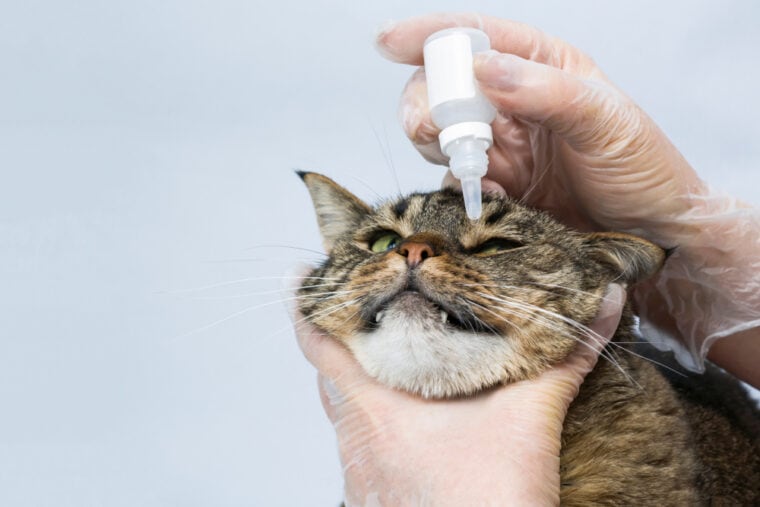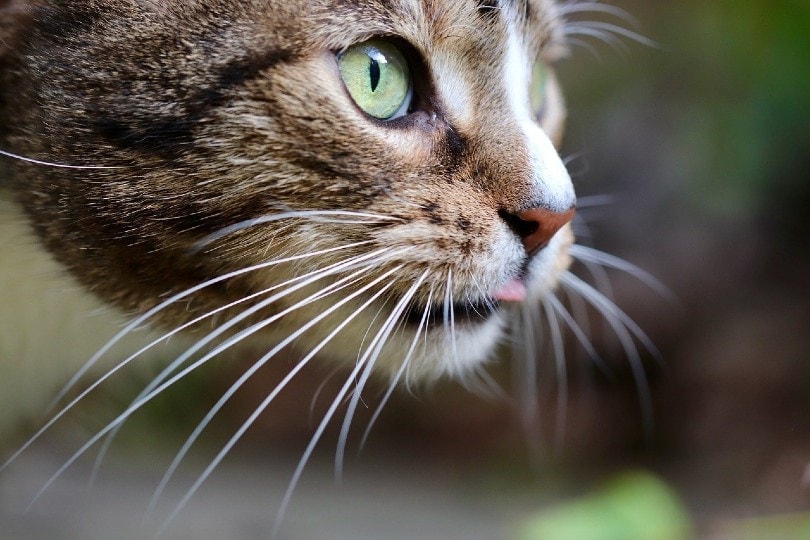
Eye drops can be lifesavers to humans. They are effective in treating redness, irritation and dryness, and they also help with more severe ailments such as infections, glaucoma, and uveitis. Since eye drops are such an effective product, can you use them on your cat if they have an eye issue or infection?
The short answer is no, you should not use eye drops on your cat unless they are artificial tears. Let’s explore this topic in more detail and what you should do should your cat develop an eye issue.
Why Can’t I Use Human Eye Drops on My Cat?
Eye drops for humans are often medicated, which can have a negative effect on your kitty. The best course of action is to take your cat to your veterinarian for treatment if you suspect your cat has an eye issue. Your vet can implement a treatment plan that is both safe and effective. Never administer eye drops intended for humans without consulting your veterinarian first, as these types of drops typically have medications that could be harmful to your cat. For example, anti-redness eyedrops may contain decongestants from the imidazolines class, such as Tetrahydrozoline. These compounds are toxic to cats when swallowed and can cause life-threatening reactions.1

What Types of Eye Drops Are Safe to Use at Home?
Suppose your cat has something in his eye. What can you do at home? You can safely use saline solution to rinse your cat’s eyes. However, ensure you read the label and avoid the product if it’s labeled as an enzymatic or a cleaning solution for contact lenses.
Artificial tears are safe to use and come in a variety of brands. Artificial tears that contain hypromellose, hyaluronic acid, or carbomer gel as the only ingredient are all safe and suitable options for lubrication, cleaning the eyes, and removing dirt and debris.
How to Administer Vet-Approved Eye Drops
If your cat has been diagnosed with an eye issue, such as conjunctivitis (pink eye), cataracts, glaucoma, inflammation, or some other problem, it may be a challenge at first administering the eye drops, but with patience, you can administer the eye drops effectively.
The first and most important step is to wash your hands thoroughly to prevent the potential spread of infection. Next, gently clean any debris from the eyes (if there is any) with warm water and a soft washcloth before administering. Without touching it, ensure that the application tip is clean before administering, and when applying, do not allow the application tip to touch the surface of the eye or the eyelid. You may need someone to assist you if your cat’s eye issue is painful. Keep in mind that with each application, the pain will lessen for your cat.
In order to protect your hands and arms, you may want to wrap your cat in a blanket with only the head exposed to keep from being clawed. Odds are your cat is not going to appreciate you trying to put something in his eyes, but try and stay patient.
Hold the bottle with the tip pointing downward. You can try and rest your hand on your cat’s head for stability. Gently pull back the eyelid and hold the bottle close to the eye, but remember to avoid letting the applicator tip touch the eye surface or eyelid. Squeeze one drop and you’re done! Your cat will probably blink and paw at the eye, but this is normal—they may drool as well, which might be normal but is worth mentioning to your vet if it is excessive. Blinking is good because it allows the eye drops to spread across the entire eye. Remember to provide your cat with plenty of praise, petting, or a treat after the procedure to ensure they develop a positive association with eye drops.
If your cat excessively paws at the treated eye or the eye becomes red or inflamed, contact your veterinarian right away.

Tips for Keeping Your Cat Safe
It’s always best to consult your vet if you notice your cat has an eye issue. Eye infections are common in cats, and if your cat has redness, irritation, mucus, or inflammation, the first step should be to have your cat treated. Your veterinarian can determine what the issue is and treat it accordingly.
When using eye drops at home for your cat, avoid eye drops for dogs as well. Only use non-medicated artificial tears or a saline solution, and avoid touching the eye with the applicator tip.
Final Thoughts
If you’re a cat owner, odds are your cat will have an eye issue at some point, especially if your cat spends time outdoors. In this case, never use human eye drops on your cat. It’s important to seek treatment as soon as possible if you notice changes in the eye, as the issue may require immediate attention.
Featured Image Credit: OlegKovalevichh







